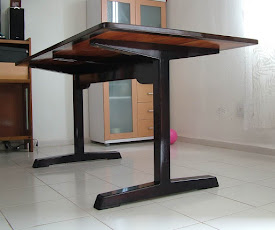[226] SPICE BOX (Part II) HAND CUT THROUGH DOVETAILS
Posted: sábado, 6 de agosto de 2011 by Superhero!! in
0
Continuing the Spice Box project...
.
The main box joinery is supposed to be hand cut through dovetails. I have never work on something similar and didn't know anything about dovetails. At some point I thought a simpler joinery made by power tools could do the job but... Where is the fun on that?, So, I took the challenge and learn something new. I found some impresive videos like this on youtube where some expert people cut dovetail joinery in 2 minutes. I also read a lot of web pages about dovetails. By the end I decided that this is the metod that could work best for me, so I tried.
..
HAND CUT THROUGH DOVETAILS
.
My first step was to mark a line to indicate the width of the boards on every mating piece. I decided to do this on both faces -inside and outside- because I needed as much guide lines as posible. There are a lot of options to do this, a marking gauge, a marking knife, a chisel, etc... I choose a common mechanic pencil -0.5 mm wide tip-, and the mating piece itself for maximum accuracy
.
.
Tails or pins first?. I believe that's a personal choice, and I choice tails first. I found a lot of diferent layouts, diferent tail sizes, and some variations on the tails angle. Some experts cut the tails without any layout, and some other uses specialized jigs. I find my own way whit a sliding bevel and a combination square.
.
.
My jaws hit the floor when I discovered that premium dovetail saws can cost up to $200 USD. No way I can get one of those, not only because the money, that kind of nice tools are not available where I live. So I have to use what I have on hand. I took this cheap back saw that came with a yellow miter box, it's 12 TPI but the saw set was to wide for dovetail cutting. It occurred to me to reset the teeth by filing them whit a sharpening stone. Believe it or not it works. I was amazed with the clean kerf, regardless I must steer very carefully to avoid binding.
Points to remember: Hold your saw like if it was a little bird, use little or no downward pressure and always saw on the waste side of your line. Am I right Mr. Schwarz?
.Points to remember: Hold your saw like if it was a little bird, use little or no downward pressure and always saw on the waste side of your line. Am I right Mr. Schwarz?
.
This is an easy step. Just grab a coping saw and remove as much waste as possible. Just be carefull not to touch the base line.
..
Then with a chisel remove the remaining waste working from both sides. I found that with little waste to be removed, and a very sharp chisel, there is almost no need of a mallet, just use my own weight to sunk the chisel down. I learn that in this step is very important to cut on the waste side of the line, don't touch it!!
..
Once the tails are finished, next step is to draw the pins on the edge of the mating piece. Clamp the mating piece leveled on the vise, then use a block at the same height in the rear side and lay the other piece with his tails on the clamped piece. Be sure everything is perfectly aligned, be sure not to move the tailed piece and draw the shape of the tails on the edge of the mating piece.
.
..
Complete the layout on the sides. Mark the waste areas with a BIG equis, then make your cuts using the same technique used on the tails.
.
.
The joint should be tight but without binding. My first joint was too tight and doesn't fit because I did my cut a bit far away from the cut line, so I had to do a lot of paring. On the other three joins I corrected that problem, I still had to do some paring but much less than the first joint.
..
After I get a nice dry fit on four corners I was ready for the glue up. First I put some masking tape on the inside corners to catch any glue squeeze, then I used band clamps to keep the box tight while the glue dries. Meanwhile a big Corona beer comes in handy...

.
.
When the glue dried I used my smoothing plane and a low angle block plane to trim and clean the protuding tails and pins. Then I sanded the whole box to 180 grit and I was done.

.
.
I am happy with the results. The joint looks fine, it is very strong, and I learned a new technique. The only downside is that each joint took me around one hour -up to the dry fit. I hope to reduce the amount of time in future joints.
.
.Nos vemos luego!!
.
.
.
You can also read:
Part I: Resaw wide boards
Part II: Hand cut through dovetails
Part III: Ogee bracet feet
Part IV: Finished project

















































